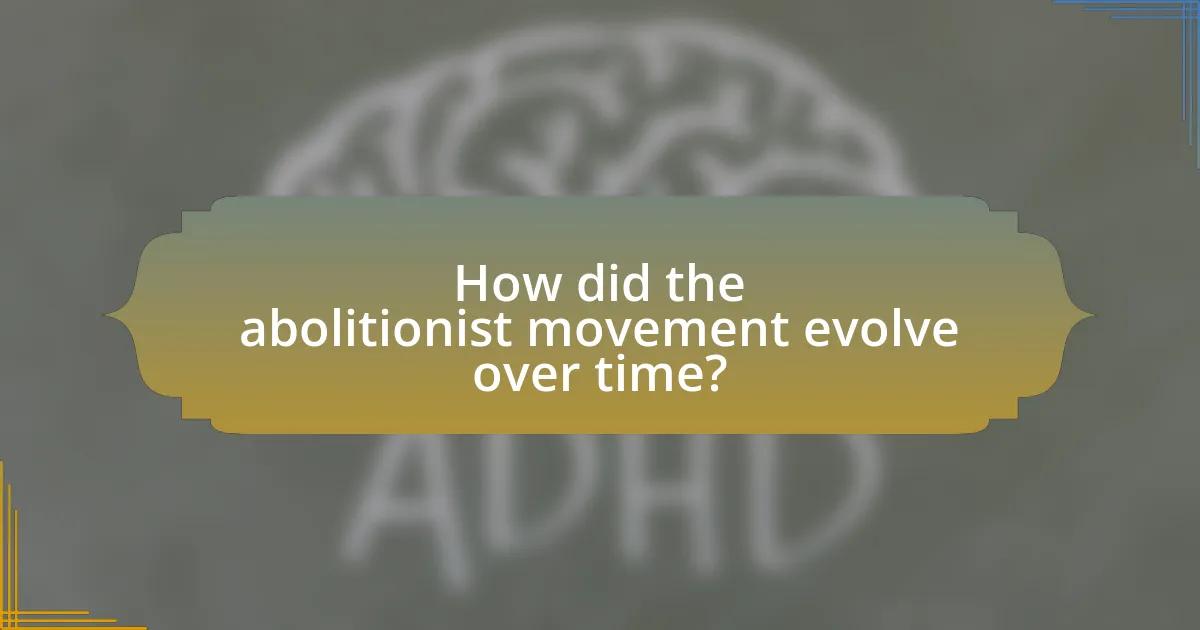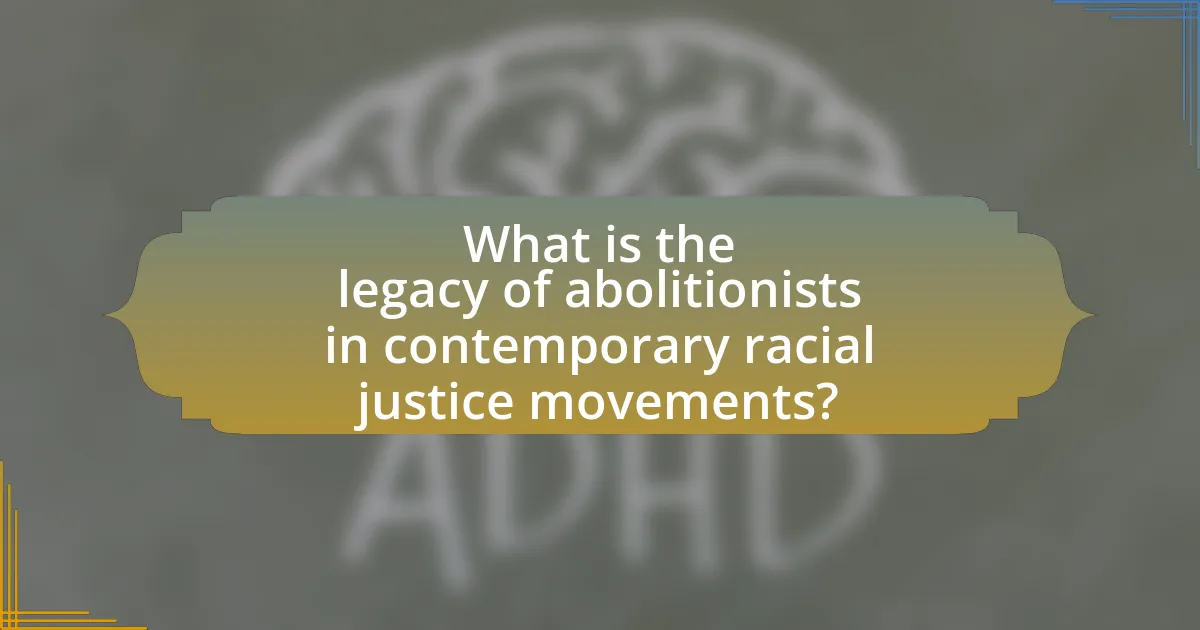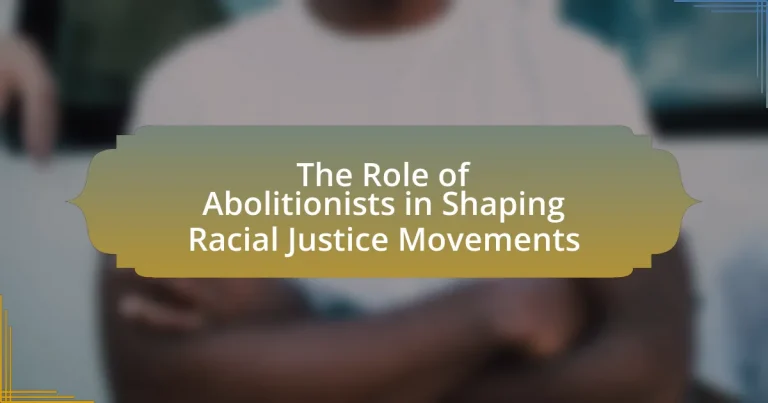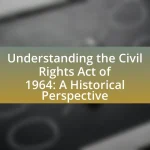The article examines the pivotal role of abolitionists in shaping racial justice movements, highlighting their advocacy for the end of slavery and the promotion of equality for all races. It discusses key figures such as Frederick Douglass and Harriet Tubman, their strategies including grassroots organizing and literature, and the evolution of the abolitionist movement over time. The article also explores the intersection of abolitionism with other social justice movements, the impact of the Civil War on abolitionist goals, and the legacy of these efforts in contemporary racial justice activism. Additionally, it outlines practical steps individuals can take to honor the contributions of abolitionists and resources available for further learning.

What was the role of abolitionists in shaping racial justice movements?
Abolitionists played a crucial role in shaping racial justice movements by advocating for the end of slavery and promoting equality for all races. Their efforts laid the groundwork for future civil rights activism, as they organized campaigns, published literature, and mobilized public opinion against the institution of slavery. Notable figures such as Frederick Douglass and Harriet Tubman not only fought for the emancipation of enslaved individuals but also emphasized the importance of racial equality, influencing subsequent movements like the Civil Rights Movement of the 1960s. The abolitionist movement’s strategies, including grassroots organizing and legal challenges, established a framework that later racial justice advocates would adopt to combat systemic racism and discrimination.
How did abolitionists influence early racial justice efforts?
Abolitionists significantly influenced early racial justice efforts by advocating for the end of slavery and promoting equality for African Americans. Their activism laid the groundwork for subsequent civil rights movements by raising awareness about racial injustices and mobilizing public opinion against slavery. Notable figures such as Frederick Douglass and Harriet Tubman not only fought for the emancipation of enslaved individuals but also emphasized the importance of civil rights, education, and social equality. The abolitionist movement’s strategies, including grassroots organizing, public speaking, and the use of literature, helped to galvanize support for racial justice, ultimately contributing to the passage of the 13th Amendment in 1865, which abolished slavery in the United States.
What strategies did abolitionists employ to advocate for racial justice?
Abolitionists employed various strategies to advocate for racial justice, including grassroots organizing, public speaking, and the use of literature. Grassroots organizing involved mobilizing communities to participate in anti-slavery activities, such as forming local abolitionist societies that coordinated efforts to end slavery. Public speaking was a powerful tool, with figures like Frederick Douglass and Sojourner Truth delivering compelling speeches that highlighted the injustices of slavery and called for immediate action. Additionally, the publication of pamphlets, newspapers, and books, such as “Uncle Tom’s Cabin” by Harriet Beecher Stowe, raised awareness and garnered support for the abolitionist cause. These strategies collectively contributed to a growing national dialogue on racial justice and ultimately influenced legislative changes, including the Emancipation Proclamation in 1863.
How did abolitionist literature contribute to racial justice awareness?
Abolitionist literature significantly contributed to racial justice awareness by exposing the brutal realities of slavery and advocating for human rights. Works such as Harriet Beecher Stowe’s “Uncle Tom’s Cabin” illustrated the inhumane conditions faced by enslaved individuals, galvanizing public opinion against slavery. Additionally, Frederick Douglass’s autobiographies provided firsthand accounts of the experiences of enslaved people, fostering empathy and understanding among readers. These literary efforts not only informed the public but also mobilized support for abolitionist movements, ultimately influencing legislation such as the Emancipation Proclamation in 1863, which marked a pivotal step toward racial justice in the United States.
What key figures emerged as abolitionist leaders in racial justice?
Key figures who emerged as abolitionist leaders in racial justice include Frederick Douglass, Harriet Tubman, and Sojourner Truth. Frederick Douglass, a former enslaved person, became a prominent orator and writer advocating for the end of slavery and equal rights, famously publishing “The North Star” to promote abolitionist ideas. Harriet Tubman, also a former enslaved individual, is renowned for her role in the Underground Railroad, leading numerous enslaved people to freedom and advocating for women’s suffrage. Sojourner Truth, an African American abolitionist and women’s rights activist, delivered the iconic “Ain’t I a Woman?” speech, highlighting the intersection of race and gender in the fight for justice. These leaders significantly influenced the abolitionist movement and laid the groundwork for future racial justice efforts.
What were the contributions of Frederick Douglass to racial justice movements?
Frederick Douglass significantly contributed to racial justice movements through his powerful advocacy for abolition and civil rights. As a former enslaved person, Douglass became a leading voice against slavery, using his eloquence and personal narrative to highlight the injustices faced by African Americans. He published several autobiographies, including “Narrative of the Life of Frederick Douglass, an American Slave,” which provided firsthand accounts of the brutality of slavery and galvanized public opinion against it. Douglass also played a crucial role in the formation of the abolitionist movement, collaborating with prominent figures like William Lloyd Garrison and participating in the founding of the American Anti-Slavery Society in 1833. His speeches, such as the famous “What to the Slave Is the Fourth of July?” delivered in 1852, challenged the moral and ethical foundations of slavery and called for immediate emancipation. Additionally, Douglass advocated for women’s rights, linking the struggles for racial and gender equality, and was a key figure at the Seneca Falls Convention in 1848. His relentless efforts in journalism, public speaking, and political engagement laid the groundwork for future civil rights movements, making him a pivotal figure in the fight for racial justice in America.
How did Harriet Tubman’s actions impact racial justice advocacy?
Harriet Tubman’s actions significantly advanced racial justice advocacy by directly challenging the institution of slavery and promoting the abolitionist movement. As a conductor of the Underground Railroad, Tubman led over 300 enslaved individuals to freedom, demonstrating the effectiveness of grassroots activism in combating systemic oppression. Her efforts not only provided immediate relief to those escaping slavery but also inspired a broader societal commitment to racial equality, as evidenced by her participation in abolitionist meetings and her collaboration with prominent figures like Frederick Douglass. Tubman’s legacy continues to influence contemporary racial justice movements, highlighting the importance of direct action and community support in the fight against racial injustice.

How did the abolitionist movement evolve over time?
The abolitionist movement evolved significantly from its early beginnings in the late 18th century to its peak during the Civil War era. Initially, abolitionists focused on moral arguments against slavery, with figures like William Lloyd Garrison advocating for immediate emancipation through publications such as “The Liberator” starting in 1831. Over time, the movement expanded to include a broader coalition of activists, including former enslaved individuals like Frederick Douglass, who emphasized the need for political action and legal reforms. By the 1850s, the movement increasingly adopted a more militant stance, exemplified by John Brown’s raid on Harpers Ferry in 1859, which aimed to incite a slave uprising. The culmination of these efforts contributed to the passage of the Thirteenth Amendment in 1865, which abolished slavery in the United States, marking a significant evolution from moral persuasion to direct political action and legal change.
What were the major milestones in the abolitionist movement?
The major milestones in the abolitionist movement include the publication of “Uncle Tom’s Cabin” in 1852, which galvanized public opinion against slavery, and the formation of the American Anti-Slavery Society in 1833, which organized efforts to end slavery. Additionally, the passage of the Emancipation Proclamation in 1863 by President Abraham Lincoln marked a significant turning point, declaring the freedom of slaves in Confederate states. The ratification of the Thirteenth Amendment in 1865, which abolished slavery in the United States, represents the culmination of the abolitionist efforts. These milestones collectively reflect the strategic actions and advocacy of abolitionists that significantly influenced the trajectory of racial justice movements in America.
How did the abolitionist movement intersect with other social justice movements?
The abolitionist movement intersected with other social justice movements by advocating for the rights of marginalized groups, including women and laborers. Prominent abolitionists like Frederick Douglass and Sojourner Truth also championed women’s suffrage, linking the fight against slavery to the struggle for gender equality. Additionally, the abolitionist movement influenced labor rights by highlighting the exploitation of workers, drawing parallels between enslaved individuals and laborers facing harsh conditions. Historical events, such as the Seneca Falls Convention in 1848, showcased the collaboration between abolitionists and early feminists, emphasizing a shared commitment to social justice.
What role did the Civil War play in advancing abolitionist goals?
The Civil War significantly advanced abolitionist goals by leading to the emancipation of enslaved individuals and the establishment of legal frameworks for their freedom. The conflict, which began in 1861, highlighted the moral and political contradictions of slavery, galvanizing abolitionist sentiment and action. The issuance of the Emancipation Proclamation by President Abraham Lincoln in 1863 declared the freedom of all enslaved people in Confederate-held territory, marking a pivotal shift towards the abolition of slavery. This executive order not only provided a moral imperative for the Union cause but also allowed for the enlistment of African American soldiers in the Union Army, further integrating formerly enslaved individuals into the fight for their own liberation. By the end of the war in 1865, the passage of the Thirteenth Amendment formally abolished slavery in the United States, solidifying the achievements of the abolitionist movement and transforming the legal landscape regarding race and freedom.
How did abolitionists respond to challenges and opposition?
Abolitionists responded to challenges and opposition by employing a combination of activism, education, and legal strategies. They organized protests, formed societies, and published literature to raise awareness about the injustices of slavery. For instance, the American Anti-Slavery Society, founded in 1833, mobilized thousands of members to advocate for the immediate emancipation of enslaved people. Additionally, abolitionists like Frederick Douglass used their personal narratives and public speaking to counter pro-slavery arguments, effectively challenging the moral and ethical justifications for slavery. Their persistent efforts contributed to shifting public opinion and ultimately influenced legislative changes, such as the Emancipation Proclamation in 1863.
What tactics did abolitionists use to counteract pro-slavery arguments?
Abolitionists employed various tactics to counteract pro-slavery arguments, including the use of moral persuasion, legal challenges, and the dissemination of literature. They highlighted the moral injustices of slavery through speeches and writings, such as those by Frederick Douglass and Harriet Beecher Stowe, which exposed the brutal realities of enslaved life. Legal challenges, such as those initiated by abolitionist groups, aimed to undermine the legal foundations of slavery, exemplified by cases like the Amistad trial in 1841. Additionally, abolitionists utilized pamphlets, newspapers, and public lectures to spread their message, effectively mobilizing public opinion against slavery and demonstrating its incompatibility with American democratic ideals. These strategies collectively contributed to a growing abolitionist movement that significantly influenced public discourse and policy regarding slavery.
How did abolitionists maintain momentum in the face of setbacks?
Abolitionists maintained momentum in the face of setbacks by leveraging grassroots organizing, persistent advocacy, and strategic alliances. Grassroots organizing involved mobilizing local communities to raise awareness and support for abolitionist causes, exemplified by the formation of societies like the American Anti-Slavery Society in 1833, which united individuals across various states. Persistent advocacy included the use of pamphlets, speeches, and public meetings to keep the issue of slavery in the public discourse, as seen in the works of prominent figures like Frederick Douglass and William Lloyd Garrison. Strategic alliances with other reform movements, such as women’s rights and labor rights, helped to broaden their base of support and maintain focus on the overarching goal of racial justice. These methods collectively ensured that abolitionists could continue their fight despite legislative and social challenges.

What is the legacy of abolitionists in contemporary racial justice movements?
The legacy of abolitionists in contemporary racial justice movements is significant, as their foundational principles of equality and human rights continue to inspire activism today. Abolitionists, such as Frederick Douglass and Harriet Tubman, emphasized the importance of dismantling oppressive systems, which resonates in current movements advocating for police reform, mass incarceration reduction, and systemic racism challenges. Their historical efforts laid the groundwork for modern organizations like Black Lives Matter, which echoes the abolitionist call for justice and equity. The abolitionist legacy is evident in the ongoing fight for civil rights, as activists draw parallels between past struggles against slavery and present-day battles against racial discrimination and inequality.
How do modern racial justice movements draw inspiration from abolitionists?
Modern racial justice movements draw inspiration from abolitionists by adopting their strategies of grassroots organizing, direct action, and the pursuit of systemic change. Abolitionists like Frederick Douglass and Harriet Tubman emphasized the importance of collective action and community mobilization to dismantle oppressive systems, which contemporary movements echo through protests, advocacy, and coalition-building. Additionally, the abolitionist framework of viewing racial injustice as a moral imperative informs the ethical foundation of modern movements, such as Black Lives Matter, which seeks to address systemic racism and police violence. Historical examples, such as the abolition of slavery in the 19th century, demonstrate the effectiveness of sustained activism, providing a blueprint for current efforts to achieve racial equity and justice.
What lessons can current activists learn from abolitionist strategies?
Current activists can learn the importance of coalition-building and grassroots organizing from abolitionist strategies. Abolitionists effectively united diverse groups, including free Blacks, white allies, and women, to create a powerful movement against slavery, exemplified by the formation of the American Anti-Slavery Society in 1833, which brought together various factions to amplify their collective voice. Additionally, the use of direct action, such as protests and underground networks like the Underground Railroad, demonstrated the effectiveness of civil disobedience in challenging unjust systems. These historical tactics highlight the necessity of collaboration and strategic action in contemporary movements for racial justice.
How have abolitionist principles been integrated into today’s racial justice frameworks?
Abolitionist principles have been integrated into today’s racial justice frameworks by emphasizing the need for systemic change and the dismantling of oppressive structures. Modern movements, such as Black Lives Matter, draw on abolitionist ideas by advocating for the defunding of police and the reallocation of resources towards community-based solutions, reflecting the historical abolitionist goal of ending slavery and creating equitable systems. This integration is evident in the call for restorative justice practices, which prioritize healing over punishment, aligning with the abolitionist vision of a society free from punitive measures. Additionally, contemporary racial justice frameworks often highlight the interconnectedness of various forms of oppression, echoing the abolitionist understanding that racial justice cannot be achieved without addressing economic, social, and political inequalities.
What practical steps can individuals take to honor the legacy of abolitionists?
Individuals can honor the legacy of abolitionists by actively engaging in education and advocacy for racial justice. This includes participating in community discussions, supporting organizations that promote racial equality, and educating oneself and others about the history and impact of abolitionist movements. For instance, individuals can read works by abolitionists like Frederick Douglass and Harriet Tubman, which provide insight into their struggles and achievements. Additionally, volunteering for or donating to groups that work towards dismantling systemic racism reinforces the ongoing fight for justice, echoing the efforts of historical abolitionists who fought against slavery and oppression.
How can community engagement promote racial justice in the spirit of abolitionism?
Community engagement can promote racial justice in the spirit of abolitionism by fostering collective action and empowering marginalized voices. This approach aligns with abolitionist principles that emphasize dismantling oppressive systems and creating equitable alternatives. For instance, community-led initiatives, such as local organizing efforts and participatory budgeting, have been shown to effectively address systemic inequalities and promote social change. Research indicates that communities actively involved in decision-making processes experience improved outcomes in areas like education and public safety, reflecting the abolitionist goal of transforming societal structures to prioritize justice and equity.
What resources are available for learning about abolitionist contributions to racial justice?
Resources for learning about abolitionist contributions to racial justice include historical texts, academic journals, documentaries, and online courses. Notable texts such as “The Narrative of the Life of Frederick Douglass” provide firsthand accounts of abolitionist efforts, while academic journals like the “Journal of African American History” publish research on the impact of abolitionists. Documentaries such as “13th” explore the historical context of racial justice movements, and platforms like Coursera offer courses on the history of abolitionism. These resources collectively highlight the significant role abolitionists played in advancing racial justice in the United States.


